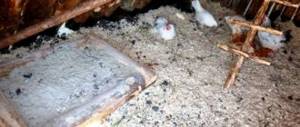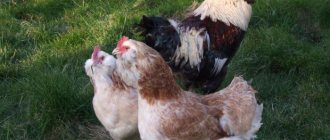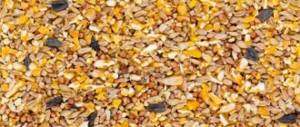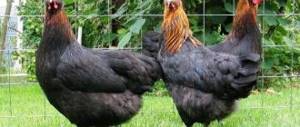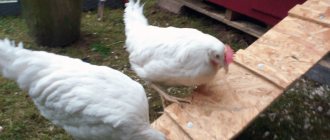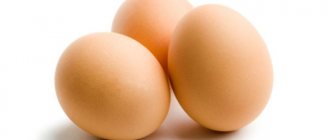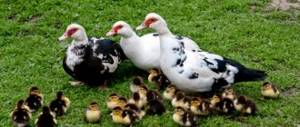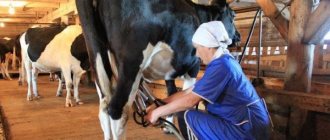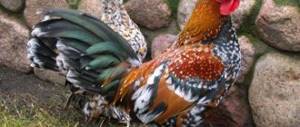Shabo breed of chickens
So, the origin story.
As you know, Shabot is called the Japanese Bantam. As you already understand, the bird’s homeland is Japan. It is difficult to trace the years of appearance, because these chickens have been known since ancient times. The Asian woman appeared in our latitudes in the 17th and 18th centuries, and immediately fell in love with the aristocratic layer of the population.
At that time, they were bred for decorative purposes - they served as decoration for the gardens and parks of noble people. Due to their unusual appearance, these layers are still more popular as a decorative type.
What does an Asian chicken look like?
In appearance, Japanese Bantams differ from other varieties of chickens. The main distinguishing feature of Asian women is their height - they have a down-to-earth body, while their paws are small, which is considered to be the breed standard. Laying hens have long wings, the edges of which can touch the ground. A small leaf-shaped comb on a relatively large head, consisting of 4-5 teeth.
As for the color of the chickens, it can be different - it depends on the variety. Shabot is a breed of chickens with feathers of different colors - porcelain, gold, red, black or wheat. The weight of these miniature beauties reaches 600-800 grams.
Description and characteristics of Shabo chickens
The main feature of the breed is its small, down-to-earth body with unequally low paws. The comparison of the body and legs is so great that it seems that the birds do not walk, but crawl. Short legs affected not only the appearance, but also the manner of behavior. Shabots are calm, not particularly active, and are characterized by excessive tolerance and equanimity.
Appearance
Due to the presence of short legs, the breed is considered an exotic ornamental. Despite their lack of mobility, Shabots are one of the hardiest representatives of small chickens. It is due to this appearance and calm nature that the Japanese bantam is a favorite breed raised for decoration.
Miniature chickens do not live long, but Shabo is distinguished by its longevity, especially with proper and regular care.
Modern representations of these birds have not changed much compared to their ancestors. Poultry farmers are trying not to lose the genetic thread connecting the former Shabos with the present ones. However, everything directly depends on the endurance of the offspring. Only the color of the chickens can be changed, which makes it possible to obtain universal specimens while maintaining excellent endurance indicators.
Main characteristics of the appearance of Shabo chickens:
- Very short legs.
- Small back and wide chest.
- Large, down-to-earth body.
- Long wings touching the ground surface.
- The head is voluminous with a small beak.
- Long tail with raised tail feathers.
- Large-scale plumage.
Chickens present an unusual motley picture of feathers of different colors, especially when the shades begin to combine with each other. The exotic appearance of Shabot chickens often becomes the reason for breeding these birds. For bantams, a cockerel with a blue tail or a hen with golden plumage is not a rarity, but a classic color.
As for the appearance of the male and female, in general they are not much different from each other. The main differences are that the chicken does not have sharp feathers on its tail and has a smaller head.
Character
Japanese women are beautiful in appearance, but they are also good in behavior. The main distinguishing feature of chickens is their innate maternal instinct. Many poultry farmers consider bantams to be a real find, because they hatch not only their own eggs, but also the eggs of other miniature chicken breeds.
For a description of the character of the Shabo chicken breed, see the video below:
Shabo's character is specific, but that's why they are loved. The cockerels of the breed are fighting, in some ways even wild. They are truly protectors of their chickens. The cockerel protects the feathered female with his whole body; he rushes into battle without fear, despite the size of his enemy.
As for communication between individuals of the same breed, Shabo is distinguished by maximum friendliness and cohesion. Representatives of this breed protect each other from uninvited guests or enemies.
Birds cannot live alone; any confinement negatively affects the behavior and health of the bird. If Shabot is kept in captivity for a long time without communicating with other representatives of the breed, then the individual stops eating and as a result dies.
In the Shabot chicken society, there is a special hierarchy where the rooster is the main one. He protects, preserves, awakens and tastes food before the females eat it.
Productivity
Full maturation of representatives of the Shabot breed occurs in the same way as with other breeds of chickens - at the age of six months, sometimes earlier. Males begin to fertilize females, and they, in turn, are ready to lay and hatch eggs.
The average egg production is 80 eggs per year. In rare cases, the figure reaches 110 eggs.
The productivity indicator is not the highest, but it is due to the following factors:
- The weight of one egg is approximately 30 g, which is half that of a classic laying hen.
- Despite their long lifespan, females quickly age and stop laying eggs. Already in the 3rd or 4th year of life, egg production decreases significantly, so females must be culled.
- Over the years, the chicken does not lose its beautiful appearance, but it is no longer possible to use it to obtain a large number of eggs of the highest quality.
- The weight of an adult female is 0.5 kg, a male is 0.7 kg.
- Bantam meat tastes more like partridge than chicken. It is very juicy and tender, and contains a small amount of fat.
What does an Asian betta look like?
The male Japanese Bantam is a cockerel, not much different from the female. Of course, it is larger, and also has a more powerful chest, massive wings, as far as possible for small birds. Cockerels, like the fair half of the flock, have different color options. Feathered gentlemen are heavier than chickens by an average of 200 grams.
Interesting fact: Baroness von Ulm Erbach was proud of her collection of chickens from Japan, which included the rarest specimens, mesmerizing in beauty.
What is the character of decorative Asians?
- Japanese bantams have a fighting character - the leaders take care of the fair half of the flock, protect and show signs of attention in every possible way. It is because of this that it is necessary to ensure maximum safety for them, because a dwarf superhero is often unable to protect his family.
- In addition, ornamental chickens are quite friendly - they do everything together, together. They stay in a flock during walks and approach the feeder in an organized manner. Fights between representatives of bantams are extremely rare.
- Chickens are not timid - they can safely approach other animals, are not afraid of people, and in general - they feel confident.
- Feathered aristocrats are unable to tolerate loneliness. If they are isolated from the bird family, they will really suffer. Isolation from family is endured tragically.
Poultry conditions and care
Shabo are heat-loving chickens, so it is advisable to breed them only in regions with a temperate climate. In the middle zone, birds are placed in a heated chicken coop. The temperature inside should not fall below +16 degrees.
High humidity and stale air have a detrimental effect on the health of birds. The chicken coop should be equipped with a ventilation system to maintain a normal microclimate. A thick bedding made of a mixture of peat and sawdust is placed on the floor to preserve heat. It perfectly absorbs bird waste. To maintain cleanliness, you need to stir it once a week.
In the poultry house, perches of standard thickness are built - 4 cm at a height of 1–1.5 m. Shabots take off easily and it is not difficult for them to climb onto a perch. Drinkers and feeders are placed on the floor in an accessible place so that each bird can easily approach and get enough. You will need few nests - one is enough for 6-7 laying hens. The boxes are usually placed in a dark corner and covered with a layer of soft straw.
When breeding shabot chickens, poultry farmers are interested in increasing the productivity of laying hens. They produce only 80 eggs per year, some of which are not fertilized. Considering that the loss of young animals is 20–25%, you will have to fight for every egg. To increase the egg production of laying hens in autumn and winter, the chicken coop is illuminated with lamps. The light should be dim, dim. The recommended daylight hours are 13 hours.
Shabo chickens have a vulnerable immune system, so it is important to clean and disinfect the chicken coop more often. Fungal spores and bacteria that multiply in litter are deadly
It is recommended to wash drinking bowls and feeders every day, and then scald them with boiling water.
Walk
Despite their slowness, Shabot chickens love to walk in the fresh air. Walking strengthens their immunity and relieves boredom. In this regard, the birds will need an area covered on all sides with a net. It is advisable to equip the walking yard with a canopy to protect the birds from the rain.
In summer, Japanese bantams can walk for an unlimited amount of time if the weather is good. In winter, when the mercury is below zero, walking is prohibited. Chabots do not tolerate frost and can catch a cold, despite the presence of thick plumage.
Feeding recommendations
Ornamental Japanese bantams eat the same food as representatives of other chicken breeds, only they need less food due to their miniature size. The basis of the bird's diet is grain - whole, steamed and sprouted. Its share of the total volume is 50%.
In addition to grain crops, Shabo chickens are given:
- legumes;
- greenery;
- vegetables;
- dairy products;
- boiled fish.
The feed is enriched with mineral additives. Twice a week, bone meal and yeast are added to the mash. Birds should receive chalk and a small amount of salt every day. The source of calcium is crushed eggshells. A bowl of fine gravel is placed near the feeder, which helps the birds grind food in their crops. The drinking bowls should always contain clean water at room temperature.
Tendency to diseases
Chickens of the Shabo breed suffer from colds more often than others. In this regard, breeders recommend keeping birds in a warm chicken coop, avoiding drafts and dampness. Walking of birds is limited in the cold season.
Japanese bantams often suffer from parasitic infections and tuberculosis. Keeping your coop clean will help prevent infestations from mites, chicken fleas, and bedbugs. To prevent tuberculosis, contact between domestic birds and wild birds should be limited. To do this, the walking yard is even covered with netting on top, and the floor of the chicken coop is poured with concrete to prevent rodents from getting inside.
Little mother
If you have Asian parrots, you definitely won't need an incubator! Despite its small size, the baby mother is ready to give her life for her offspring - without a moment’s hesitation. Mommy can serve as an example for many animals and even people!
The tiny mother carefully warms the testicles she lays, and after the squeaky cubs appear, she does not leave her babies for a second. Mothers take care of their babies until they grow up, warming them under their large wings, walking them and bravely protecting them from any dangers.
The dwarf mother conveys life experience to the kids, cleans the feathers, and disperses the little fighters to different ends of the poultry house. Looking at such a spectacle, it is impossible not to be touched! And what is even more remarkable is that the cockerel supports the hen in her motherhood, caring and protecting.
Interesting fact:
Due to their well-developed maternal instinct, Japanese laying hens are often invited to become foster mothers for chicks of other breeds whose mothers are not caring for them.
Peculiarities
- Low, wide, down-to-earth body.
- Short back.
- Convex chest.
- Very short legs.
- There is lush plumage on the neck.
- The wings are long and touch the ground.
- The head is large, mostly painted in red tones.
- Large leaf-shaped comb. Teeth – from 4 to 5.
- The beak is strong and short. Its color matches the color of the plumage.
- Long straight tail.
- The tail feathers are carried high.
- Plumage of various tones: striped, black and silver, porcelain, black and gold, wheaten, yellow body and black tail.
The appearance of hens is in many ways similar to roosters. How to distinguish them:
- The head is smaller.
- The ridge is not so massive and often hangs to one side.
- There are no sharp braids in the tail.
Maternal instinct is highly developed. They carefully and carefully incubate the eggs and take care of the hatched chicks. This feature is used by poultry farmers.
Japanese Bantams are often “invited” to be hens on the eggs of other species of ornamental (and not only) birds.
Features of dwarf offspring
From the information above, you already understand that chicks are born not just small, but completely tiny. You can freely place 5-7 day old chicks on a human palm. The great tragedy is that babies are born weak, which is why some die.
Scientists say the problem has roots in chicken genetics. Experienced breeders recommend “marrying” individuals with paws of different lengths, because it is precisely because of this that squeaky babies die.
Little Japanese need special care - warmth, ideal cleanliness and special nutritional supplements increase the chances of survival of the chicks.
Babies are especially sensitive to temperature changes and high humidity, which can cause them to get sick and die. At the same time, the diet of children does not differ from the traditional one.
Climate and maintenance features
If you are planning to breed dwarf hens, it is important to take into account their heat-loving nature and inability to adapt to cold.
Feathered ladies are sensitive, like real aristocrats, and instantly react to any draft or high humidity. Given this feature, it is not recommended to keep them in harsh climatic conditions - in the north.
The rules for keeping Asian dwarfs are not very different from other breeds. Here are the most important nuances.
- A clean and dry chicken coop - warm bedding needs to be replaced in a timely manner.
- A layer of sand in the house is not a luxury, but a necessity if you do not want them to suffer from parasites.
- Possibility of free walking in a safe area during the warm season. Of course, there is the possibility of cellular maintenance, but in this case the viability is significantly reduced.
- They need supplements containing calcium, minerals and vitamins from the first days. It is especially important to feed laying hens during the brooding period.
What you need to know about care and maintenance
Shabots are heat-loving breeds that require a warm room. It is necessary to check the building for the absence of drafts, which can destroy the entire livestock, and there should also be no excess humidity. It can very often lead to colds. The chicken coop must be clean. The most commonly used bedding is:
- straw;
- wood shavings;
- hay;
- crushed sunflower stems.
Experts categorically do not recommend using polystyrene foam granules. Chickens may begin to feast on inedible material, which will lead to clogging of the crop; also, you should not use foam boards as insulation.
Perches with a height of no more than one and a half meters should be installed in the room. It won’t be difficult to take off on such landing pads for chabots. In terms of width, it is best to adhere to the standard of about 5 cm. To ensure that chickens feel good, they are equipped with walking yards where they can go with the onset of the warm season. Here it is important not to forget to tighten the mesh to prevent escapes.
For shabot, it is necessary to provide a balanced and nutritious diet. As a base, you can give different mixtures of grains with different components. Green food, vitamin and mineral complexes must be present. You can give feed that is suitable for a particular age group. As a rule, these granules contain everything that chickens need.
Age-related problems of decorative chaff
The difference between Japanese bantams is that they do not have the so-called juvenile molt. With age, the beauty clump does not lose its attractiveness. But, over the years, the laying hen can no longer perform her duties as deftly.
Therefore, after 3-4 years, it is necessary to raise a new generation to replace the old women.
Frequent diseases of decorative Japanese women
It has already been said above that Japanese women are sensitive and susceptible to various natural factors, changing conditions, and this negatively affects their protective functions. Most often, black whales suffer from parasitic diseases and tuberculosis (in this case, the carcasses are burned and the chicken coop is completely disinfected).
But by creating good living conditions, the risk of morbidity and increased mortality can be reduced.
Description of the breed
AppearanceBreeding and rearingProductivity
The head is large, wide, with a red face. The beak is small, strong, and can be of different colors (depending on the color of the bird). The comb is large, leaf-shaped, fleshy, with 4-5 large teeth visible. The earrings are large and red. The lobes are red and smooth.
- The body is stocky, wide, short. The back is short and wide.
- The legs are very short, the metatarsals are colored depending on the color of the feathers.
- The tail is long, set high, straight.
- The wings are long and reach the ground.
- The plumage is smooth (most common), curly (less common), silky (very rare).
Chickens have a strong resemblance to cockerels, differing in a small set of characteristics:
- smaller head;
- wings of medium length;
- a miniature comb hanging to one side;
- absence of sharp braids in the tail.
Representatives of the breed are distinguished by their fighting character. This is especially noticeable in the behavior of cockerels, which show signs of attention to chickens and protect them.
The livestock are very friendly, staying together at the feeder and during walks. Isolation is extremely difficult to bear. Fights practically never happen . They are not shy with other inhabitants of the yard and with humans; they easily make contact due to their sociability. The bird's loudness is also noted.
The breed reproduces well without human intervention . The hens take perfect care of their offspring: they warm the laid eggs, do not separate from the hatched chicks, warm them, walk them and protect them from any potential dangers. The hen takes care of her offspring until they grow up. The rooster also shows a desire to protect its offspring, manifested in care and protection.
Sexual maturity is reached at 5-6 months. It is at this age that it is recommended to buy chickens for breeding .
The proportion of fertilized eggs in the clutch is 50-70%. The survival rate of chickens is low, in most cases it ranges from 50-60%.
To increase survival rate, it is recommended to cross individuals with different paw lengths.
The planned replacement of the herd occurs after 3-4 years.
Advantages:
- attractive appearance;
- excellent brooding instinct;
- minimal feed consumption;
- calm character.
Flaws:
- low survival rate of young animals;
- cold intolerance;
- demanding conditions of detention.
The breed has no crosses.
The eggs are nutritious and do not differ in composition and taste from large eggs laid by egg breeds. The meat is tender, similar in taste to partridge meat.
Chickens reach maturity at 5-6 months. Egg production is uniform due to the absence of juvenile molting. Optimal qualities are achieved by 7-8 months, productivity is maintained until 3-4 years of age.
Chicken crosses: how do they differ from breed and hybrid?
Read
Is it possible to keep chickens in SNT, a private house, a city, or a country house?
Answer
Why do chickens peck each other until they bleed and what to do about it?
Causes of pecking
Flaws
- Increased sensitivity.
- Weak immunity.
- High mortality rate of young animals.
- The Shabo breed of chickens is demanding in special conditions.
So the article about one of the most beautiful and interesting birds has come to an end. As a result: the reviews are more positive.
Good luck and success to you!
Share the material on social networks - let your friends also learn the features of Shabo!
Subscribe to site updates and you will always be the first to receive new, interesting information about feathered beauties! Did you like our tips? Share with friends on social media. networks! See modern products for poultry and livestock farmers that improve the health of pets and make our work easier.
Maintenance and cultivation
Bantams, which include the Shabo chicken breed, are vocal, sociable, friendly birds. They do not require special conditions of detention. There are some subtleties that need to be taken into account by those who are planning to breed these bright, unusual birds:
- They love warmth. For winter maintenance, insulated premises are needed. In a cold poultry house they die.
- Food and water are the same as for large breeds: cottage cheese, grain, food waste, greens. A sufficient amount of vitamins, a varied diet - and the chickens will be healthy and full of strength.
- Poultry farmers with extensive experience advise when breeding to select parents according to this principle: one with short, standard legs, the second with limbs slightly longer than normal. If you take both short-legged parents, their offspring will be very weak.
The first photo shows several individuals of this breed sitting on a stick:
Here you see a small private farm where these beautiful little chickens are bred:
But this photo shows young chickens of the Shabo breed:
A lovely pair of white Chabots, seemingly posing for a photograph:
Excellent red laying hen in a small but comfortable cage:
